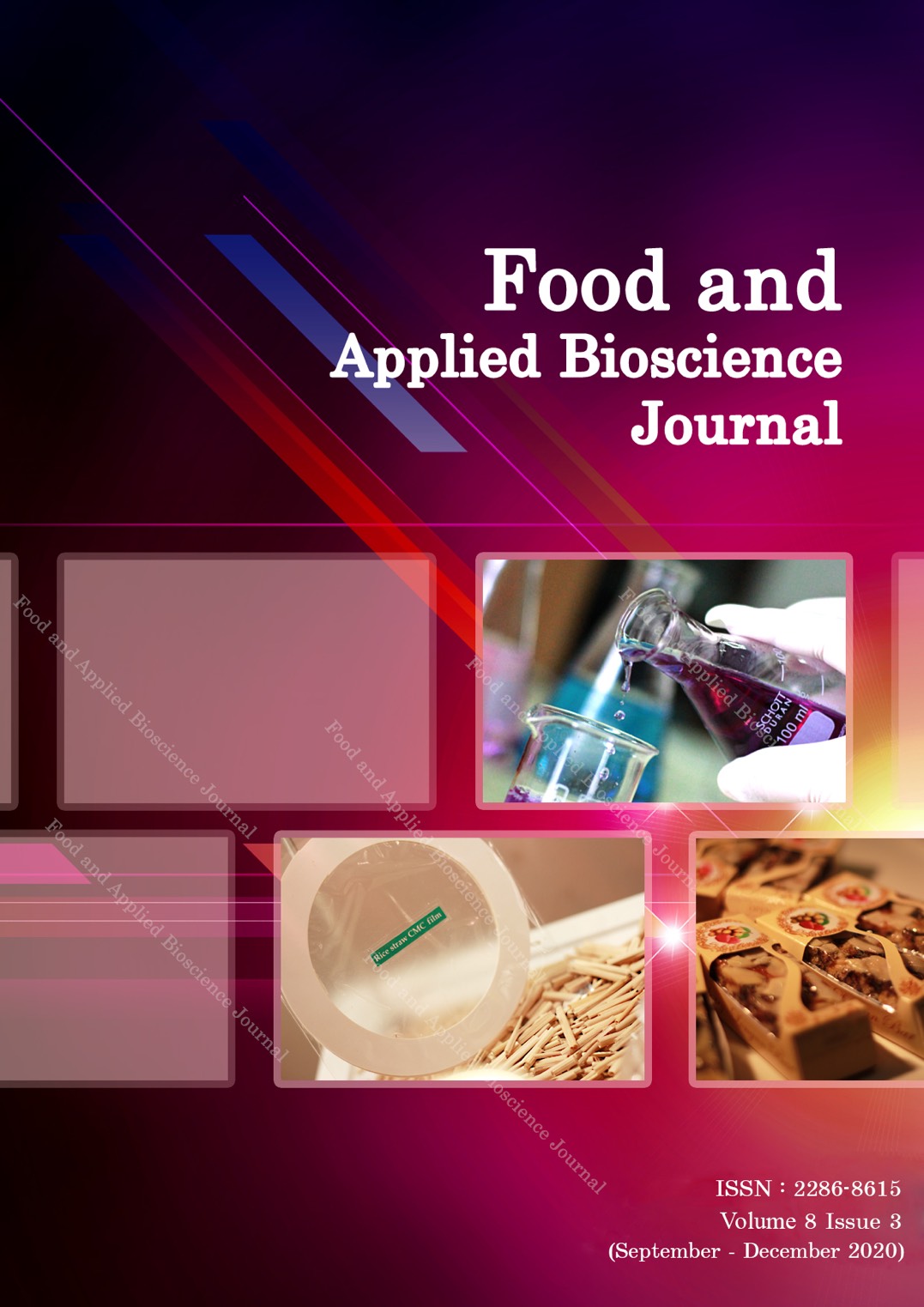Drying temperature of corn silk tea: physical properties, total phenolic content, antioxidant activity and flavonoid content
Keywords:
Corn silk tea, Antioxidant activity, Phenolic content, Flavonoid contentAbstract
Corn silk (Stigma maydis) has been used in traditional herbal medicine that it has been reported to be potentially antioxidant and healthcare applications. Corn silk may be used as fresh, however is commonly dried before being consumed as a tea or extract. Corn silk tea is produced by basic technology as drying process in terms of commercial product. Then, this research interested the suitable temperature for drying process of corn silk tea at 40, 50 and 60°C. The physical properties of corn silk tea including moisture content, water activity and color values were determined. The moisture content of dried corn silk at 40°C was significantly different from 50 and 60°C. The water activity of dried corn silk showed significantly different at all temperatures. Corn silk tea was studied the antioxidant activity (DPPH method), total phenolic content and flavonoids content in different solutions such as 95°C water, 50 %EtOH and 80 %EtOH. The result showed that the drying temperature and solution affected the total phenolic content. Dried corn silk at 40°C in 95°C water had the highest total phenolic content. Nevertheless, corn silk tea at different drying temperatures with 80% EtOH showed lower antioxidant activity, which was approximately 52.9 ± 0.8 to 61.4 ± 2.7 mg GAE/mL of free radical scavenging. Flavonoid content of corn silk tea at 50°C drying temperature with 95°C water showed the highest content, which was approximately 517.54 ± 10.21 mg CE/mL sample (P<0.05). Therefore, these results could be applied as a guide in the corn silk tea production for improving product quality.
References
Chong, K.L. and Lim, Y.Y. 2012. Effects of drying on the antioxidant properties of herbal tea from selected Vitex species. Journal of Food Quality. 35: 51–59.
Dmowski, P. and Ruszkowska, M. 2016. Studies on the hygroscopicity of some black teas in terms of terms of their storage stability. URL (https://zeszyty.umg.edu.pl/sites/default/files/ ZN440.pdf) (12 December 2019).
Dmowski, P. and Ruszkowska, M. 2018. Equilibrium Moisture Content Importance in Safe Maritime Transport of Black Tea. The International Journal on Marine Navigation and Safety of Sea Transportation. 12(2): 399-404.
Hijazi, A., Al Masri, D.S., Farhan, H., Nasser, M., Rammal, H. and Annan, H. 2015. Effect of Different Ethanol Concentrations, Using Different Extraction Techniques, on the Antioxidant Capacity of Lebanese Eryngium creticum. Journal of Pharmaceutical, Chemical and Biological. 3(2): 262-271.
Ho, Y.M., Wan Amir Nizam, W.A. and Wan Rosli, W. 2016. Antioxidative activities and polyphenolic content of different varieties of malaysian young corn ear and cornsilk. Sains Malaysiana 45(2): 195–200.
Khairunnisa, H., Puziah, H. and and Shuhaimi, M. 2012. Corn Silk (Stigma Maydis) in Healthcare: A Phytochemical and Pharmacological Review. Molecules. 17: 9697-9715.
Kilic, C., Can, Z., Yilmaz, A. Yildiz, S. and Turna, H. 2017. Antioxidant Properties of Some Herbal Teas (Green tea, Senna, Corn Silk, Rosemary) Brewed at Different Temperatures. International Journal Secondary Metabolite. 4(3): 142-148.
Kopjar, M., Tadic, M. and Pilizota, V. 2015. Phenol content and antioxidant activity of green, yellow and black tea leaves. Chemical and Biological Technologies in Agriculture. 2: 1-6.
Liu, J., Wang, C., Wang, Z., Zhang, C., Lu, S. and Liu, J. (2011). The antioxidant and free-radical scavenging activities of extract and fractions from corn silk (Zea mays L.) and related flavone glycosides. Food Chemistry. 126(1): 261-269.
Nawaz, H., Muzaffar, S., Aslam, M. and Ahmad, S. 2018. Phytochemical Composition: Antioxidant Potential and Biological Activities of Corn (pp. 49-68). URL (DOI: 10.5772/intechopen.79648) (12 December 2019).
Nawaz, H., Aslam, M. and Muntaha, S.T. 2019. Effect of Solvent Polarity and Extraction Method on Phytochemical Composition and Antioxidant Potential of Corn Silk. Free Radicals and Antioxidants. 9(1): 5-11.
Nhu Hao, N., Poonlarp, P. and Khiewnavawongsa, S. 2018. Drying of Mint and Basil Leaves for The Herbal Blended Beverage Development. Food and Applied Bioscience Journal. 6(3): 167–181.
Nurhanan, A.R. and Wan, Rosli, W.I. 2012. Evaluation of Polyphenol Content and Antioxidant Activities of Some Selected Organic and Aqueous Extracts of Cornsilk (Zea Mays Hairs). Journal of Medical and Bioengineering. 1(1): 48-51.
Rice-Evans, C.A., Miller, N.Y., Bolwell, P.G., Bramley, P.M. and Pridham, J.B. 1995. The relative antioxidant activities of plant-derived polyphenolic flavonoids. Free Radical Research. 22(4): 375-382.
Saikaew, K., Lertrat, K., Ketthaisong, D., Meenune, M. and Tangwongchai, R. 2018. Influence of variety and maturity on bioactive compounds and antioxidant activity of purple waxy corn (Zea mays L. var. ceratina). International Food Research Journal 25(5): 1985-1995.
Sarepoua, E., Tangwongchai, R., Suriharn, B. and Lertrat, K. 2013. Relationships between phytochemicals and antioxidant activity in corn silk. International Food Research Journal 20(5): 2073-2079.
Saeed, N, Khan, M.R. and Shabbir, M. 2012. Antioxidant activity, total phenolic and total flavonoid contents of whole plant extracts Torilis leptophylla L. BMC Complementary and Alternative Medicine. 12(221): 1-12.
Susantikarn, P. and Donlao, N. 2016. Optimization of green tea extracts spray drying as affected by temperature and maltodextrin content. International Food Research Journal 23(3): 1327-1331.
Teshome, K., Debela, A. and Garedew, W. 2013. Effect of Drying Temperature and Duration on Biochemical Composition and Quality of Black Tea (Camellia sinensis L.) O. Kuntze at Wush Wush, South Western Ethiopia. Asian Journal of Plant Sciences 12(6-8): 235-240.
Topuz, A., Dincer, C., Torun, M., Tontul, I., Sahin-Nadeem, H., Haznedar, A. and Ozdemir, F. 2014. Physicochemical properties of Turkish green tea powder: effects of shooting period, shading, and clone. Turkish Journal of Agriculture and Forestry. 38: 233-241.
Tsai, T.H., Tsai, T.H., Chien, Y.C., Lee, C.W., & Tsai, P.J. (2008). In vitro antimicrobial activities against cariogenic streptococci and their antioxidant capacities: A comparative study of green tea versus different herbs. Food Chemistry. 110(4): 859-864.
Zilic, S., Jankovic, M., Basic, Z., Vancetovic, J. and Maksimovic, V. 2016. Antioxidant activity, phenolic profile, chlorophyll and mineral matter content of corn silk (Zea may L): Comparison with medicinal herbs. Journal of Cereal Science. 69: 363-370.
Heim, K.E., Tagliaferro, A.R. and Bobilya, D.J. 2002. Flavonoid antioxidants: chemistry metabolism and structure-activity relationship. The Journal of Nutritional Biochemistry. 13(10): 562-584.






